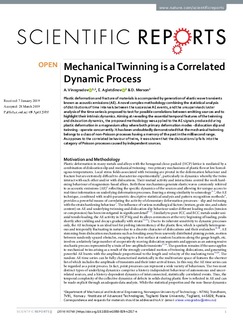| dc.contributor.author | Vinogradov, Alexey | |
| dc.contributor.author | Agletdinov, E | |
| dc.contributor.author | Merson, D | |
| dc.date.accessioned | 2019-09-27T12:28:46Z | |
| dc.date.available | 2019-09-27T12:28:46Z | |
| dc.date.created | 2019-07-02T13:41:40Z | |
| dc.date.issued | 2019 | |
| dc.identifier.citation | Scientific Reports. 2019, 9 (1), 1-13. | nb_NO |
| dc.identifier.issn | 2045-2322 | |
| dc.identifier.uri | http://hdl.handle.net/11250/2619157 | |
| dc.description.abstract | Plastic deformation and fracture of materials is accompanied by generation of elastic wave transients known as acoustic emissions (AE). A novel complex methodology combining the statistical analysis of distributions of time intervals between the successive AE events, and the unsupervised cluster analysis of the time series is proposed to test for possible correlations between emitting sources and to highlight their intrinsic dynamics. Aiming at revealing the essential temporal features of the twinning and dislocation dynamics, the proposed methodology was applied to the AE signals produced during plastic deformation in a magnesium alloy where both primary deformation modes - dislocation slip and twinning - operate concurrently. It has been undoubtedly demonstrated that the mechanical twinning belongs to a class of non-Poisson processes having a memory of the past in the millisecond range. As opposes to the correlated behaviour of twins, it was shown that the dislocation slip falls into the category of Poisson processes caused by independent sources. | nb_NO |
| dc.language.iso | eng | nb_NO |
| dc.publisher | Nature Research | nb_NO |
| dc.rights | Navngivelse 4.0 Internasjonal | * |
| dc.rights.uri | http://creativecommons.org/licenses/by/4.0/deed.no | * |
| dc.title | Mechanical Twinning is a Correlated Dynamic Process | nb_NO |
| dc.type | Journal article | nb_NO |
| dc.type | Peer reviewed | nb_NO |
| dc.description.version | publishedVersion | nb_NO |
| dc.source.pagenumber | 1-13 | nb_NO |
| dc.source.volume | 9 | nb_NO |
| dc.source.journal | Scientific Reports | nb_NO |
| dc.source.issue | 1 | nb_NO |
| dc.identifier.doi | 10.1038/s41598-019-42317-4 | |
| dc.identifier.cristin | 1709410 | |
| dc.description.localcode | Open Access This article is licensed under a Creative Commons Attribution 4.0 International License, which permits use, sharing, adaptation, distribution and reproduction in any medium or format, as long as you give appropriate credit to the original author(s) and the source, provide a link to the Cre- ative Commons license, and indicate if changes were made. The images or other third party material in this article are included in the article’s Creative Commons license, unless indicated otherwise in a credit line to the material. If material is not included in the article’s Creative Commons license and your intended use is not per- mitted by statutory regulation or exceeds the permitted use, you will need to obtain permission directly from the copyright holder. To view a copy of this license, visit http://creativecommons.org/licenses/by/4.0/. © The Author(s) 2019 | nb_NO |
| cristin.unitcode | 194,64,92,0 | |
| cristin.unitname | Institutt for maskinteknikk og produksjon | |
| cristin.ispublished | true | |
| cristin.fulltext | original | |
| cristin.qualitycode | 1 | |

